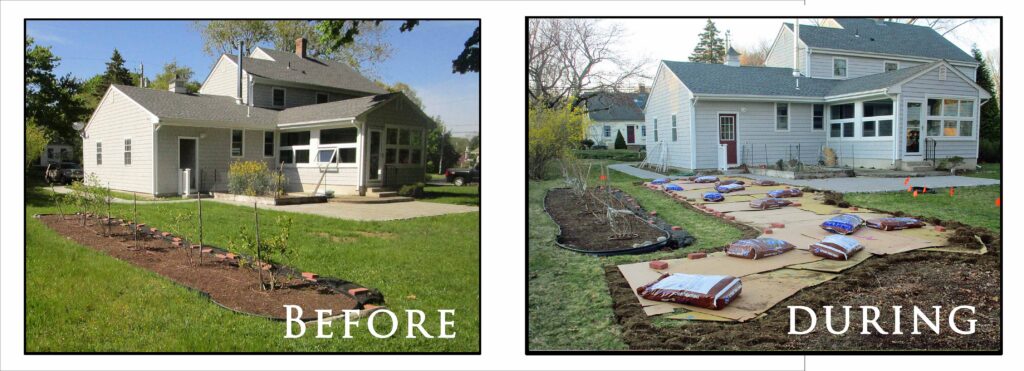Enhancing curb appeal

Landscape design before and after photos in Sharon, MA. The initial site assessment included discussion of a facelift for the front door entry area. A columned portico was added, and the concrete stairs and landing faced with veneer stone. Leading from the driveway to the front door, a curved, cobblestone-edged brick path replaced a straight asphalt runner, creating a planting area for a welcoming native eastern redbud tree (Cercis canadensis). To the right of the front door, a raised retaining wall of round rocks created structure and depth for foundation shrub plantings including native red-twig dogwood (Cornus sericea).
Ecological landscape design is for people who:
- Want their kids and grandkids, pets, pollinators and birds to romp and fly around their yard in a healthy habitat that supports the web of life – without the health risks of conventional landscape practices and chemicals
- Steward their land and value collaboration with nature and the environment more than having a perfectly manicured lawn and landscape
- Use their resources wisely, save time and money, and enjoy a robust, sometimes messy, natural landscape
Turn you lawn into a pollinator and habitat garden

You can turn your turf lawn into a pollinator garden. The sheet composting technique shown here covers lawn with two layers of cardboard to keep the grass from absorbing sunlight. The next step is to lay down drip irrigation lines that will tie into existing irrigation system on an existing zone – and run automatically on the system timer. Then we’ll add 3-4 inches of high quality organic matter, such as leaf compost – aka leaf mulch – then plant native trees, shrubs and perennials directly through the cardboard – by simply cutting a hole through it.
How to keep your design natural:
- We start with a three-fold discovery process—one to help tease out your vision, dream and lifestyle; one for existing site conditions—to discover what the site may robustly support with the least input of resources, over time; and one to establish expectations, knowing that design and installation are just the beginning of a natural process where maintenance (time and money) is everything. In other words, what is your dream, and how can we manifest it in a way that is reasonable and realistic for you?
- Once we have these in place, Carol will sketch out concept design(s) for discussion that will bring to the surface further info about what makes sense for you – and doesn’t.
- The process is iterative and collaborative, and we’ll create a master plan for success that can be implemented over time.
- Plant selection will be at least 2/3 native plants that support local wildlife and our broader shared ecosystem that supports the whole web of life.
